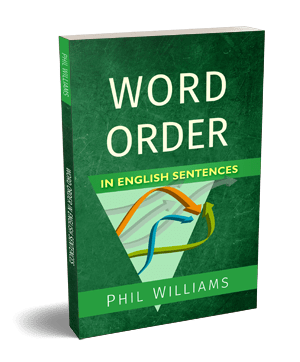
I often discuss breaking down sentence structure and word order to demonstrate how understanding sentence components helps provide flexibility with structure. You can use the full word order guide to help with this here.
Today, though, I’d like to discuss cases when it makes sense to choose a particular order based on a logical flow of information, where standard word order is maybe not the best choice, or reordering sentences could impact your intended meaning. This is not a question of grammar, but effective communication, and I’ll mostly focus on narrative timing to demonstrate this.
When “Correct” Sentence Structure is Problematic
A common issue I encounter in editing books is where something is described followed by information that would have been more effective coming first. This can be in descriptions of people and objects or the order of actions. It can also occur on a structural level, in paragraphs of chapters, but I’m going to be focusing on the sentence level here.
There are countless ways this can occur and it will always depend on the context (as does everything!), but most simply I see this as an issue where framing details come after the information they should frame. For example:
- There was an armchair in his living room, in his home, which was a castle.
There’s nothing essentially wrong with this sentence, except that we’re describing things in reverse order, from small to big, instead of setting the scene before placing things in it. The impact here is that it gives a rather scattered impression, with the reader having to reassess what they are seeing as they go (this works well in humour, but less effectively if you want to build a clear impression).
The key is to pay attention to what information you’d like someone to understand first to set a scene, before placing finer details in it. How important this is depends on what you are describing – essentially I’d warn that if there is anything a reader might find surprising, and you don’t want it to be a surprising twist (such as that castle detail), put it sooner.
In describing actions, the nuances of this can be more subtle. Particularly with shorter sentences, we don’t always need things to be in a simple linear order, as is clear by the fact that regular word order typically puts time phrases in a later position:
- She ate a cake after coming home.
It becomes more of an issue with longer sentences. When actions are described in detail before something else that already happened, it can create a narrative that feels like it’s jumping around. For example:
- He took the teabag out after brewing it for five minutes, once the kettle had boiled.
This sentence essentially tells us the events in reverse. It is grammatically correct and fairly clear, so I wouldn’t necessarily stop and say we must change it, but you can decide for yourself if a more logical sequence, presenting the action in the order that it happens, creates a better flow:
- Once the kettle had boiled, he brewed the tea for five minutes and took the teabag out.
This is a fairly innocuous example though. It matters more when you have details that could jar a reader out of the moment – again, if something might surprise them or might have helped establish the current scene. With events out of order, the timing itself may also become confusing:
- Sheila booked herself a cruise in the Pacific and enjoyed three months in the sun, away from everything, before settling down in a nice cottage in the countryside, after she retired.
Hopefully it’s clear here why the “after she retired” detail feels out of place at the end, as a detail that is tagged on, when in fact it is the detail that enables everything else. On its own, with this order, this sentence isn’t fully clear – did she retire before the cruise, or between the cruise and settling down in the cottage?
Again, I’d recommend presenting longer sentences in the order that events happen, so we can follow the action logically. And this is especially true, and apparent, when we include dialogue. With dialogue, we are creating a moment for the reader to experience, and if something is quoted followed by an action that preceded it, that moment is broken. For example:
- “Can I have some tea?” Winona asked, after she came into the room.
This is a backwards way of presenting the action as we’re already hearing the dialogue, picturing her saying it, only to then be shown her entering the room, which has already happened. If you want a reader to clearly picture a scene, it helps to keep things in order.
This doesn’t just apply to issues of clarity, though – mixing up the sequence of your sentences can affect tension, emphasis and other areas. There are reasons that we might specifically want to frame things differently (more on that below), but without one of those reasons, I’d suggest making things clearest for the reader by presenting actions in a logical order.
How to Keep Things Logical
There are two key tricks I’d look out for here in structuring your sentences to follow a logical/linear progression:
- Present details in a deliberate order, typically starting with the bigger picture and anything surprising or notable before getting into finer details.
- Present actions in the order that they occur, avoiding telling us about something that happened after we’ve already seen an action that followed it.
Two words you can look out for when considering the sequence of actions are “after” and “before” (and any similar phrases). For the most part, it makes sense to front-load adverbials that start with “after” (as these are events that came first) and to have adverbials that start with “before” later (as these are events that follow). The examples below illustrate this:
- After getting his car, he drove to the market. NOT He drove to the market after getting in his car.
- She bought the cheesecake in the market before she ate it all. NOT Before she ate it all, she bought the cheesecake in the market.
Again, though, there’s nothing necessarily wrong with these sentences on their own, but it’s a good practice to follow/be aware of for the times when it will matter.
When to Disregard Logical Order
As I said above, there are plenty of reasons we might not want to stick to a logical order. English sentence structure is, after all, flexible, and sentences can make sense in various orders. This is another case though where I would say whatever order you present your information, you should be aware of it, and have a reason for your sentence structure choices. This equally applies to both deviating from standard word order, where the time usually comes later (e.g. because we want to show a preceding event first), and in sticking to standard word order (e.g. because it is a short sentence or the sequence of events itself isn’t important/likely to cause confusion).
When we don’t use a linear order for presenting details or timed events, it’s usually because that information is less important and the order won’t affect understanding, or it’s because information presented out of sequence is more notable. Standard sentence order places time adverbials later in the sentence, which puts the emphasis on the active verb/subject, rather than the sequence of events itself. For example:
- She passed her driving test after only five lessons. (This puts more emphasis on the result, passing.)
Otherwise, giving us descriptive details or narrative sequences that don’t follow the expected, logical order, can also be good for deliberately adding emphasis or creating a surprise, which might be useful in creating either humour or tension. As with the castle example we started with, this can be a hallmark of absurdist humour:
- She rode to work instead of taking her car, but couldn’t find anywhere to stable her camel.
This sentence deliberately holds back the crucial detail, that she rode on a camel, to deliver it as a surprise. But if you merely wanted to paint a picture, where the point is anything but providing a surprise, it makes more sense to be clear:
- She rode her camel to work instead of her car, but the stables were full.
If in doubt, and you just want to be clear, consider what the most logical order is for a reader to receive the information you’re presenting, and how learning things in a different order will affect their understanding or reaction.







